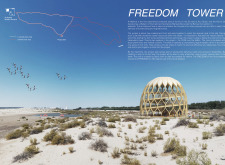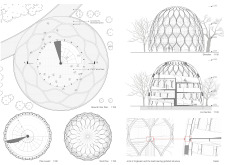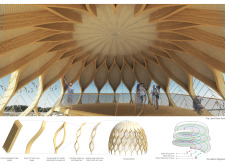5 key facts about this project
One of the principal functions of the Freedom Tower is to provide an elevated platform for visitors to experience the unique ecological characteristics of the wetland. It includes multi-level observation decks that ensure a 360-degree view of the surrounding landscape, fostering an appreciation of the flora and fauna present in this biodiverse area. The architecture integrates seamlessly with the natural environment, creating an immersive experience for guests.
Innovative Material Utilization
The design utilizes Cross-Laminated Timber (CLT) for its primary structure, a renewable material known for its environmental benefits and structural integrity. The CLT framework allows for a lightweight yet sturdy construction, significantly reducing the building's carbon footprint. Additionally, the use of a fabric roof complements the overall design by providing necessary shade while minimizing heat gain. The combination of these materials enhances the structure’s connection to its surroundings, evidencing a commitment to sustainable practices.
Accessibility as Design Philosophy
A standout feature of the Freedom Tower is its focus on accessibility. The architectural layout includes wide pathways and gradual ramps, ensuring that individuals of all abilities can navigate the building easily. This inclusivity principle is integral to the design, reflecting a more social approach to architecture that prioritizes community engagement.
Secondary Structural Elements
In addition to its main framework, the design incorporates a secondary structural layer that includes mesh facades. These facades not only enhance the building's aesthetic appeal but also serve functional purposes by offering unobstructed views while maintaining safety for users. The integration of these elements shows a deliberate intention to create a supportive environment for visitor interaction with the wetland.
Explore the Freedom Tower presentation for more details, including architectural plans, architectural sections, and architectural ideas that highlight the innovative design approaches undertaken in this project. By reviewing these elements, visitors can gain deeper insights into the underlying concepts and functional considerations that define the Freedom Tower.


























